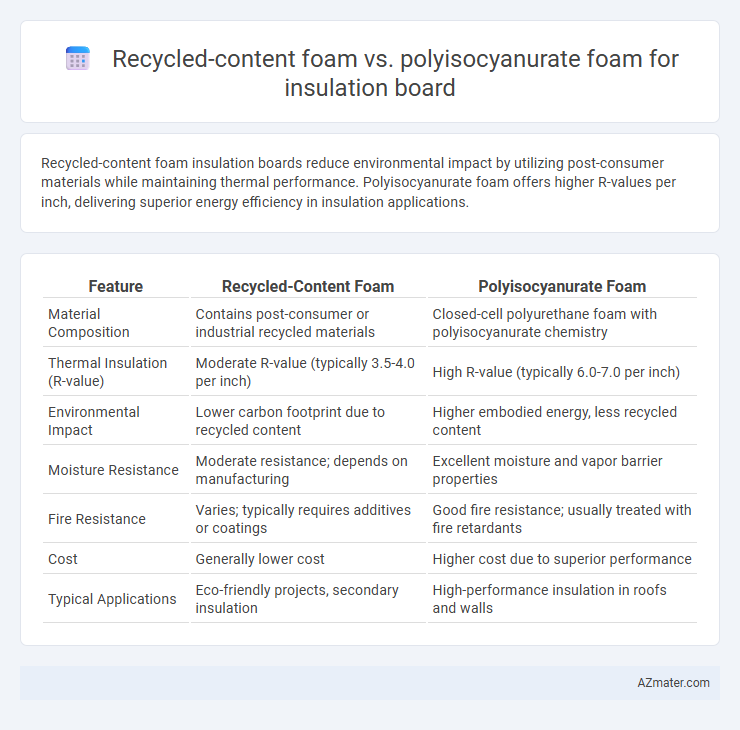Recycled-content foam insulation boards reduce environmental impact by utilizing post-consumer materials while maintaining thermal performance. Polyisocyanurate foam offers higher R-values per inch, delivering superior energy efficiency in insulation applications.
Table of Comparison
| Feature | Recycled-Content Foam | Polyisocyanurate Foam |
|---|---|---|
| Material Composition | Contains post-consumer or industrial recycled materials | Closed-cell polyurethane foam with polyisocyanurate chemistry |
| Thermal Insulation (R-value) | Moderate R-value (typically 3.5-4.0 per inch) | High R-value (typically 6.0-7.0 per inch) |
| Environmental Impact | Lower carbon footprint due to recycled content | Higher embodied energy, less recycled content |
| Moisture Resistance | Moderate resistance; depends on manufacturing | Excellent moisture and vapor barrier properties |
| Fire Resistance | Varies; typically requires additives or coatings | Good fire resistance; usually treated with fire retardants |
| Cost | Generally lower cost | Higher cost due to superior performance |
| Typical Applications | Eco-friendly projects, secondary insulation | High-performance insulation in roofs and walls |
Overview of Insulation Board Materials
Recycled-content foam insulation boards offer eco-friendly thermal performance by incorporating post-consumer or industrial waste materials, reducing environmental impact without compromising R-value efficiency. Polyisocyanurate foam boards provide a high R-value per inch, superior fire resistance, and moisture tolerance, making them ideal for commercial and residential roof and wall insulation. Both materials feature rigid formulations but differ in sustainability emphasis, with recycled-content foam prioritizing resource conservation and polyisocyanurate focusing on optimal thermal insulation and durability.
What is Recycled-Content Foam?
Recycled-content foam is an insulation material manufactured using post-consumer or post-industrial waste, reducing environmental impact by diverting plastics and foam scraps from landfills. It retains thermal resistance comparable to traditional polyisocyanurate foam while promoting sustainability through the use of recycled raw materials. This foam type offers eco-friendly insulation solutions for building envelopes, combining energy efficiency with reduced carbon footprint.
Understanding Polyisocyanurate (PIR) Foam
Polyisocyanurate (PIR) foam is a rigid insulation material known for its high thermal resistance and excellent fire performance, making it a preferred choice in energy-efficient building designs. Unlike recycled-content foam, PIR foam's closed-cell structure offers superior moisture resistance and dimensional stability, enhancing building envelope durability. Its core chemical composition combines isocyanate and polyol with added fire retardants, optimizing performance in thermal insulation boards.
Thermal Performance Comparison
Recycled-content foam insulation boards offer moderate thermal performance with R-values typically ranging from 3.5 to 4.5 per inch, whereas polyisocyanurate foam boards provide superior insulation efficiency with R-values between 6 and 7 per inch. The higher R-value of polyisocyanurate foam results in better thermal resistance, leading to more effective energy savings and reduced heat transfer in building envelope applications. Though recycled-content foam uses sustainable materials, polyisocyanurate foam's enhanced thermal properties make it the preferred choice for high-performance insulation systems.
Environmental Impact and Sustainability
Recycled-content foam insulation boards reduce landfill waste and carbon footprint by utilizing post-consumer or industrial materials, contributing to circular economy goals. Polyisocyanurate foam offers high thermal resistance and energy efficiency, but its production involves petrochemical resources and potential greenhouse gas emissions. Choosing recycled-content foam enhances environmental sustainability through resource conservation and lower embodied energy compared to traditional polyisocyanurate insulation.
Cost Differences and Affordability
Recycled-content foam insulation boards generally offer a lower initial cost compared to polyisocyanurate foam, making them a more budget-friendly option for large-scale or cost-sensitive projects. Polyisocyanurate foam, known for its superior R-value per inch and higher thermal performance, commands a premium price that can impact project budgets but often results in long-term energy savings. When affordability is prioritized, recycled-content foam provides an economical choice, while polyisocyanurate foam may justify its higher expense through enhanced insulation efficiency and durability.
Moisture and Fire Resistance
Recycled-content foam insulation boards offer enhanced moisture resistance due to additives that reduce water absorption, making them suitable for damp environments. Polyisocyanurate (PIR) foam excels in fire resistance, featuring a high thermal stability with a char-forming surface that slows flame spread. While recycled-content foam prioritizes eco-friendliness and moisture control, PIR foam is often preferred in applications demanding superior fire safety and insulation performance.
Installation and Handling Considerations
Recycled-content foam insulation boards offer easier handling due to their lighter weight and increased flexibility compared to polyisocyanurate foam, which is denser and more rigid, requiring careful cutting and fitting. Polyisocyanurate boards often necessitate protective gear to prevent skin irritation from dust and sharp edges during installation, whereas recycled-content foam poses fewer hazards. Proper storage conditions are crucial for both materials to prevent moisture absorption and deformation, but polyisocyanurate's closed-cell structure provides superior dimensional stability in humid environments.
Lifespan and Durability Factors
Recycled-content foam insulation boards offer enhanced environmental benefits but generally have a shorter lifespan and lower durability compared to polyisocyanurate foam, which is known for its superior thermal stability and resistance to moisture and compression over time. Polyisocyanurate foam typically maintains its R-value and structural integrity for 30 to 40 years, making it ideal for long-term insulation projects. Recycled foam, while cost-effective and eco-friendly, may degrade faster under harsh environmental conditions, reducing its overall effectiveness and requiring more frequent replacement.
Choosing the Right Insulation: Key Takeaways
Recycled-content foam insulation boards offer enhanced environmental benefits by reducing waste and lowering carbon footprints compared to traditional polyisocyanurate foam, which provides superior thermal resistance with R-values typically ranging from 6 to 7 per inch. Polyisocyanurate foam excels in high-performance applications requiring moisture resistance and fire retardancy, whereas recycled-content foam prioritizes sustainability and reduced environmental impact. Selecting the right insulation balances long-term energy efficiency needs with eco-friendly materials, ensuring optimal thermal performance and sustainability goals are met.

Infographic: Recycled-content foam vs Polyisocyanurate foam for Insulation board
 azmater.com
azmater.com